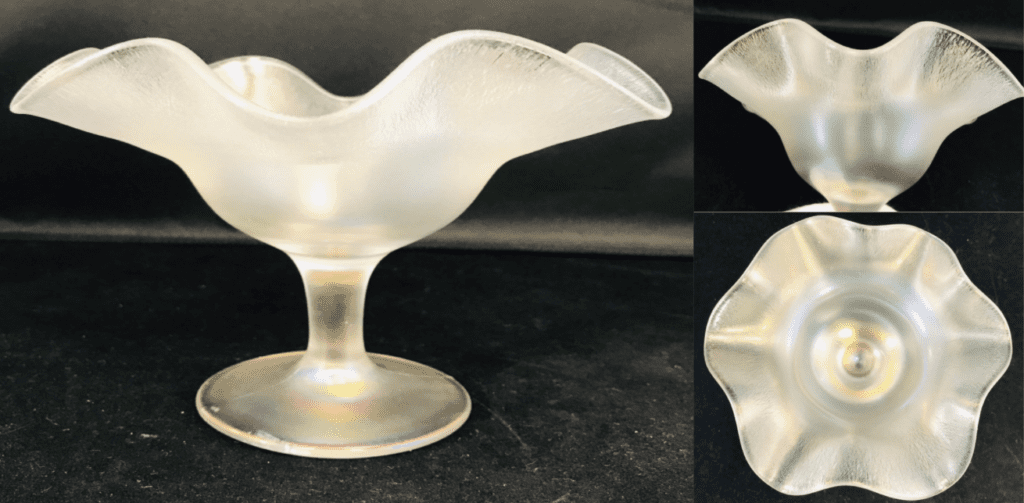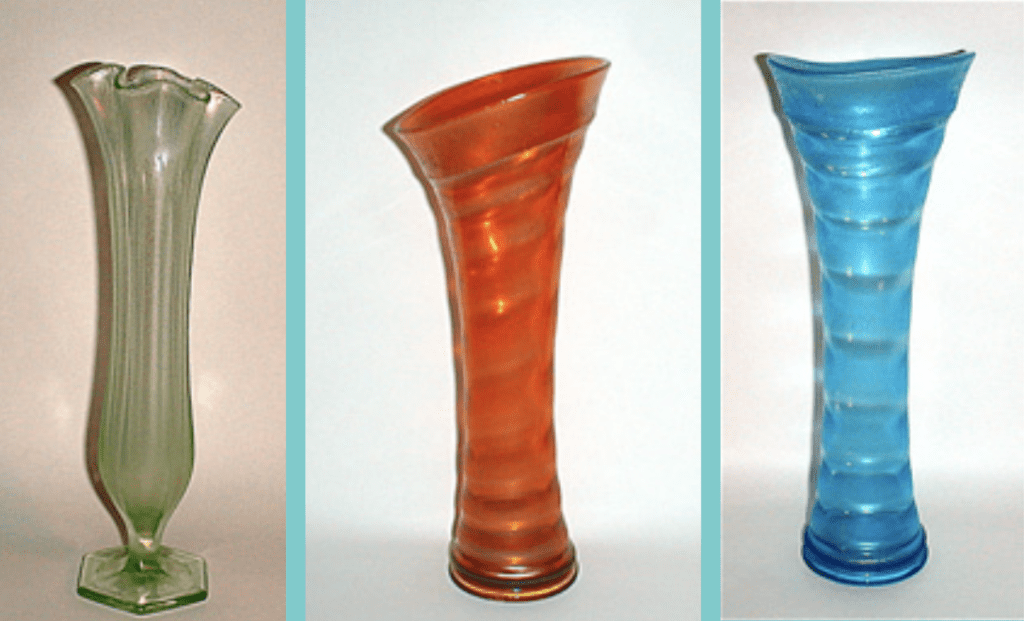While some would think that tears or marks in a work of art are mistakes, these are the features that set Stretch Glass apart from all others. Stretch Glass makes itself unique in that way, helping it to stand out among its competitors.
Vintage Stretch Glass is a type of glass that is made in a mold, then covered with a metallic spray to give the glassware an iridescent appearance. This spray also makes the exterior glass expand at a slower rate than the interior glass, causing “stretch marks” to form along the surface.
Let’s dive into the history and beauty of this form of glassware. There’s a lot more under the surface than simply its “stretch marks.”

The History of Stretch Glass
Stretch Glass was first made in 1916 in West Virginia, Ohio, and Pennsylvania and lasted in popularity until about 1935. Though it has stayed as an antique since then, Fenton Art Glass actually brought it back onto their production line from 1980 to 2011; meaning, not every Stretch Glass piece you run into will be vintage.
The top American companies who produced Stretch Glass were Diamond Glass-ware Company, Fenton Art Glass Company, Imperial Glass Company, H. Northwood & Company, and the United States Glass Company. Other companies include Works of Wheeling, Jeannette Glass Company, Lancaster Glass Company, and Vineland Flint Glass Works.

At the height of Stretch Glass’s popularity, it wasn’t actually called “Stretch”—many of these glass companies called it Rainbow, Crackle, Lustre, Cobweb, Iridescent, and so forth. As time has gone by though, it’s been easiest to identify the glassware based on its stretch marks that set it apart from other techniques, thus being dubbed Stretch glass.
Stretch Glass also got some other nicknames relating to Tiffany’s, another glass company that made glassware that was far more expensive than Stretch Glass. Yet, since it looked very similar to its more expensive counterpart, people started calling it “Tiffany,” or “Poor Man’s Tiffany,” to be more accurate.
Techniques Behind Stretch Glass
What makes Stretch Glass so special is the way it is made. The glass is first pressed into a mold to get its shape. Once it has cooled down a bit, it’s then sprayed with a metallic salts mixture that gives it its iridescent finish. The glass is then stuck back in the oven, where the outside cools faster than the interior, causing the stretch marks. And now all that’s left to do is work the Stretch Glass.

Unlike other glassware, Stretch Glass needs to be iridized first before it’s worked. However, this means that Stretch Glass pieces tend to not be heavily detailed, as any of those patterns might melt when it’s stuck back in the oven the second time.
Carnival Glass, on the other hand, gets worked first and then iridized. This means that it is able to have more patterns than stretch glass. In fact, you will find more ornate designs on Carnival Glass that can be almost as detailed as some paintings or drawings you would find on paper. Or, if it’s not displaying details of realistic items, then you’ll see beautiful and intricate patterns, things that would melt on Stretch Glass.
At the most, Stretch Glass can barely handle a simple pattern, so you’ll find no depictions of flowers, houses, or other objects that you might see on Carnival Glass.
And while the Stretch Glass will already show signs of stretching, you can increase the stretched effect by reworking the glass through methods like flaring, crimping, pulling the edges, etc. [Source]. Whether they’re small marks or the distinct effects that helped Stretch Glass get its nicknames of “Onion Skin” and “Cobwebs,” the Stretch Glass will still be stretched—it just depends on how much you want it displayed.

Stretch Glass comes in many colors since it’s defined by its technique, not its shape or size. While the rarest color is Royal Blue, you can also find it in Persian Pearl, Celeste Blue, Grecian Gold, Velva Rose, and so forth. This means that what Stretch Glass lacks in details or patterns, it more than makes up for in technique and effort.
By leaving the window narrow for options with Stretch Glass, more time is taken on using interesting colors or shapes. The thing that really makes Stretch Glass stand out is its stretch marks and iridescence, making it so that its uniqueness can be found in the simplicity of the piece.
Some of my favorite pieces of stretch glass are swung glass vases that are finished as stretch glass.

Resources to Glass Societies
If you’re interested in learning more about the glass—whether to collect, create, or appreciate—and are wanting to find ways to be involved, there are many different resources out there for you to try.
For example, the Stretch Glass Society has a variety of options for you to explore, including announcements about events, information about Stretch Glass and how to identify pieces, and even clubs that are all over the country to join. Along with that, the Stretch Glass Society lists numerous glass museums to visit, where you are able to educate yourself more on not only Stretch Glass but also on other glass forms and glass antiques.

You can also look at examples of Stretch Glass by going to this collector’s website, where they hold and sell many different types of Stretch Glass pieces that go for many different prices. This is a great place to view a variety of each form, where you’ll be able to pick out your favorite and what you want to invest in or even practice.
If you would prefer to go into more detail about Stress Glass, there are tons of books or other texts you can use to teach yourself more about this glass form. These will display images of certain glass designs and help you to differentiate glass forms from each other.
And if you’re looking to make glass, there are lots of different opportunities to try out this art form! While it’s not suggested to start with Stretch Glass, you can certainly work your way up to it. All you have to do is search in your local area and find some classes to take that will help you experiment and find your style. And who knows? Maybe you’ll find yourself able to make Stretch Glass before you know it!


